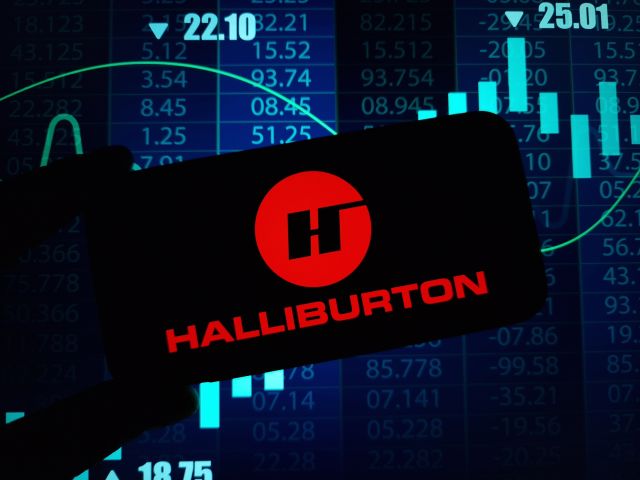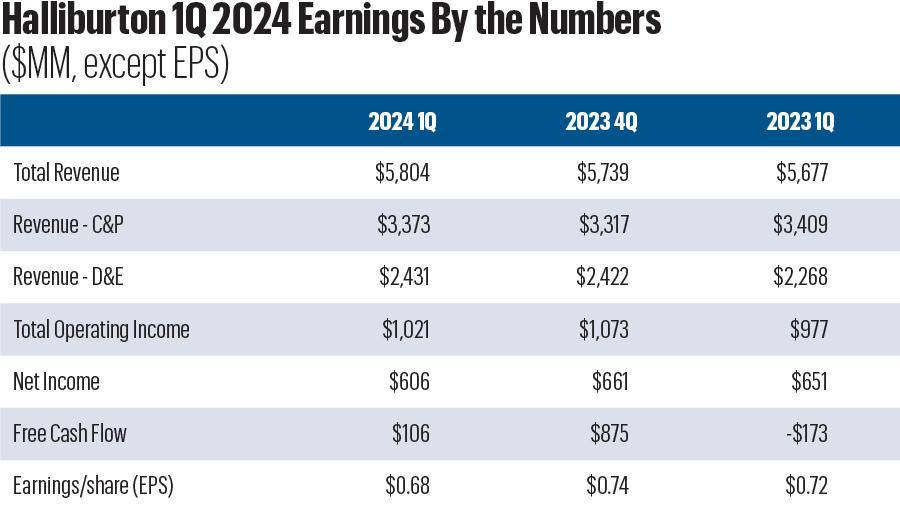
Halliburton repurchased 250 million in its common stock during the first three months of the year. (Source: Shutterstock)
Oilfield services giant Halliburton likes M&A when it comes to buying technology, but not entire corporations, CEO Jeff Miller told analysts during a first-quarter earnings call with analysts April 23.

The firm’s acquisitions calculus is geared toward advancing its own research or accelerating the movement of products to market, he said.
Evercore ISI’s Neil Mehta asked about Halliburton’s M&A plans, given the historic run of the company’s clients in the E&P space and the April 2 announcement that rival SLB intends to spend a cool $7.76 billion in an all-stock deal for ChampionX.
Still, Halliburton is unswayed.
“We see significant organic growth in the businesses that we’re in,” Miller said. “Also, I believe that organic growth generates more value for shareholders. We’ve seen that with other things that we’ve done in terms of small acquisitions that were able to then grow and push our channel.”
And just in case that wasn’t clear enough, Miller added, “We like the space where we compete, and we like the technology and how we develop that. And so you shouldn't expect any change from Halliburton.”
Global growth
Indeed, Halliburton’s 2024 growth trajectory domestically and around the world is holding its own, first-quarter numbers show.
Halliburton’s international growth increased 12% year-over-year for the period—marking an 11th consecutive quarterly trend—and low double-digit growth is expected for the remainder of the year. Strong adoption and increasing demand for Halliburton’s tools, such as the Earth Star X logging-while-drilling system and its Reservoir Xaminer Formation Testing Service, are both creating meaningful value for customers and driving market growth for the company, Miller said.
“Equally important, the international market remains tight for equipment and people,” Miller said. “Therefore, we expect to see margin expansion” beyond 2023.
Latin American revenue came in at $1.1 billion during the first three months of the year, a 21% increase from the same period in 2023. The improvement was driven primarily by Mexico’s heightened need for drilling-related services and increased software sales; improved pressure pumping services and fluids in Argentina; and increased activity across broad product lines in Brazil and Ecuador.
North American revenue declined 8% year-over-year, a result of less onshore pressure pumping in the U.S. and lower line activity, Miller said. Still, the quarterly figure represents a 5% increase from fourth-quarter 2023.

Unconventional surge
After a long track record in U.S. shale, Miller said he is consistently noticing more global interest in unconventionals.
“I can recall over a decade ago that global scramble to find unconventionals with limited success,” he said.
Markets outside of North America are achieving scale, he said; that creates a new opening for Halliburton.
“The technologies and processes Halliburton developed as the leader in North America over the last three decades have broad applications to unconventional reservoirs throughout the world, which makes this a fantastic long-term opportunity for Halliburton,” he said. “I am confident in the duration of this international upcycle in 2024 and beyond.”
North American revenue is expected to remain flat for the rest of the year after the slight increase since the fourth quarter. The trend is consistent with the “more industrialized approach to asset development” in North America, Miller said.
“While we expect an eventual recovery in natural gas activity driven by demand from LNG expansions, our 2024 plan does not anticipate this recovery overall.”
Future demand
Global energy use is on the rise, with crude forecasted to increase by up to 2.3 MMbbl/d this year, Miller said.
“This demand growth is greatest in non-OECD (Organization for Economic Co-operation and Development) countries where we expect more per capita energy consumption—not less—as they develop their economies and improve their quality of life globally,” he said.
And in the U.S., Miller expects electricity demand to swell by more than 15% by 2030, following two decades of stability. Some 40% of the nation’s electricity is supplied by natural gas.
“We expect strong demand for natural gas as a base fuel well into the future,” he said.
“Everything I see points toward long-term growth for Halliburton’s services.”
Recommended Reading
Pioneer Energy’s Tech Offers More Pad Throughput, Fewer Emissions
2025-01-14 - Pioneer Energy’s Emission Control Treater technology reduces emissions and can boost a well’s crude yield by 5% to10%, executives say.
ZENRG Capitalizing on New Investments, Tech to Reduce Emissions
2025-01-07 - ZENRG Services recently secured funding from Chevron, BP Energy Partners and EIC Rose Rock to support its expansion of compression technology that keeps methane from being vented or flared.
BYOP (Bring Your Own Power): The Great AI Race for Electrons
2025-01-06 - Data-center developers, scrambling to secure 24/7 power, are calling on U.S. producers to meet demand as natgas offers the quickest way to get more electrons into the taps.
Microseismic Tech Breaks New Ground in CO2 Storage
2025-01-02 - Microseismic technology has proved its value in unconventional wells, and new applications could enable monitoring of sequestered CO2 and facilitate geothermal energy extraction.
Small Steps: The Continuous Journey of Drilling Automation
2024-12-26 - Incremental improvements in drilling technology lead to significant advancements.
Comments
Add new comment
This conversation is moderated according to Hart Energy community rules. Please read the rules before joining the discussion. If you’re experiencing any technical problems, please contact our customer care team.





